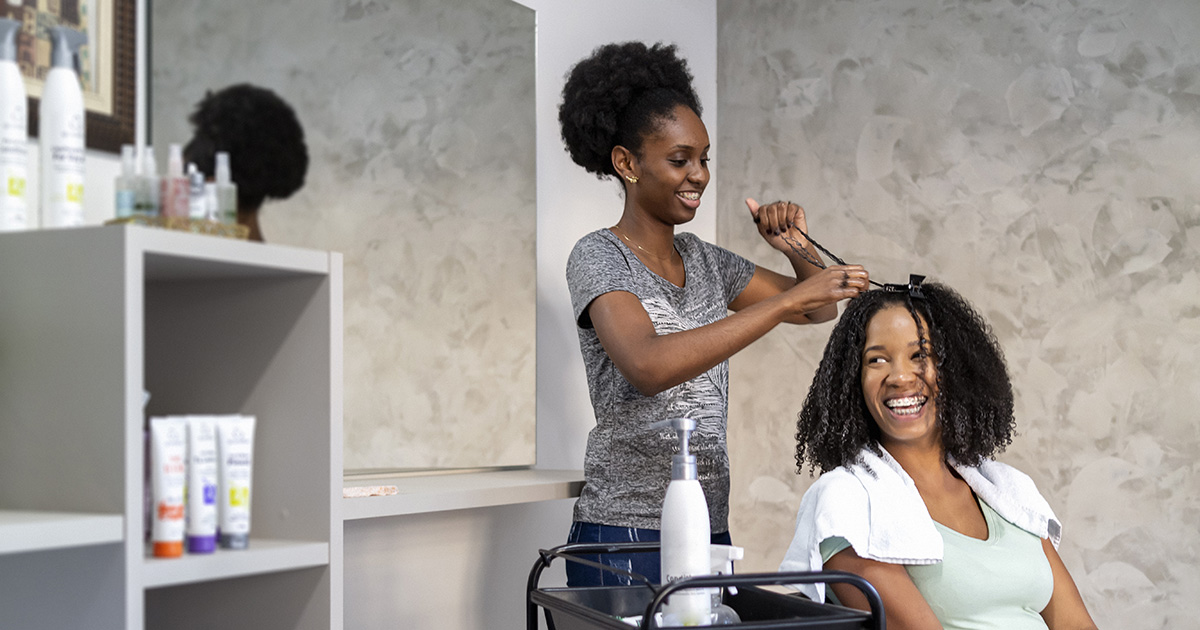Increased uterine cancer risk for Black women? What you need to know about hair dyes and straighteners

The American Cancer Society estimates that nearly 66,000 new uterine and endometrial cancer cases will be diagnosed in the United States within the next year.
Although uterine cancer accounts for only about 3% of all new cancer cases in the United States, it is the most common cancer in women. It is on the rise, particularly in Black women in comparison to white women.
Uterine cancer is also more common in Black women; statistically, those diagnosed with it are more likely to die from it. Significant disparities in uterine cancer have been reported for decades, spurring further research to determine why this may be happening.
Is there a link between uterine cancer, chemical hair straighteners and hair dyes?
These products are suspected of containing harmful chemicals with endocrine-disrupting and carcinogenic properties. Previous studies have found their use associated with a higher risk of hormone-sensitive cancers, including breast and ovarian cancer.
A recent study by the National Institute of Health is the first diverse study that has looked into a possible relationship with uterine cancer.
A few things to note about the study:
- It wasn’t originally designed to look at uterine cancer risks but to take a closer look at a higher-risk population concerning any genetic and environmental risk of developing breast cancer. Called “The Sister Study,” it enrolled women without a history of breast cancer who have at least one sister diagnosed with breast cancer
- Although it wasn’t explicitly designed to look at uterine cancer, researchers were able to collect a large amount of information about uterine cancer that warrants more research
- It defined the “frequent use” of chemical hair straighteners and permanent hair dyes more than four times per year. Because it is thought that Black women use hair straightening or relaxer products more frequently, and possibly at earlier ages, they may be at higher risk
- It also looked at the difference between receiving hair treatments versus giving treatments, although hair stylists were excluded from the study
“The advantage of this study is that it’s a rigorous, cohort study which decreases bias and includes a diverse population, although only 7.4% of participants were Black women,” says Ashley Greenwood, MD, Nebraska Medicine gynecologic oncologist. “They also looked at a possible correlation of hormone regulation which gives a potential biologic plausibility to their hypothesis.”
What the research study tells us
While there was no statistically significant increased risk of uterine cancer among Black women shown in this study, it did show a significantly increased risk of uterine cancer with frequent use of permanent hair color and chemical straighteners.
These findings are consistent with prior studies linking these products to a possible increase in breast and ovarian cancer. They found little to no increase in these cancers for semi-permanent or temporary hair dye use.
Bottom line: There seems to be an association, but more research is needed.
“Although this study looks at environmental factors, it’s not a smoking gun,” says Dr. Greenwood. “I would call this more of a hypothesis-generating study. But we need to figure out why this is happening and continue increasing the diversity in these studies.”
Why this research study is important
Reason one: Diversity
Research studies need to reflect the people the medical community treats by being inclusive and respectful as we partner in further studies. “Studies like these are important not only because they are looking at environmental risk factors but because we still have much work to do with a much higher diversity ratio,” adds Dr. Greenwood.
Reason two: To find answers about worse outcomes
Uterine cancer is one of the only cancers with an increased occurrence and mortality rate over time. “Despite matching for numerous controlled confounders (factors), we know that black women do worse,” adds Dr. Greenwood. “It’s not a difference in disease, stage, socioeconomic status, insurance status or even biology. Something is happening, making black women have poorer outcomes than their white counterparts.”
How can Black women reduce their uterine cancer risk?
“The development of uterine cancer has multiple factors, but if you are already at higher risk, you may want to think about reducing the frequency of using these products,” advises Dr. Greenwood. “Work on the areas you can control. Talk with your doctor if you feel like something is off, keep up with regular check-ups and screenings, and be your own health advocate.”
Defined risk factors:
- Family history
- Age
- Weight
- Irregular periods not due to birth control or other medication to alter them
- Unopposed hormone use
- Postmenopausal bleeding
“If you have a uterus and are thinking about going on hormone replacement therapy, make sure you are also taking progestins to protect the lining of your uterus,” adds Dr. Greenwood. “It’s important for both hormones to be balanced.”
Should Black women stop using chemical straighteners and permanent dyes altogether?
Sometimes headlines can be scary. If something concerning catches your eye on social media or the news, resist the urge to panic. The best approach is to stay calm and seek more information by talking with your doctor about your concerns.
“It’s good to be aware of studies like this one, but based on the information available right now, I don’t feel like we should necessarily rush to make wholesale changes to our hair care practices,” says Kristie Hayes, MD, Nebraska Medicine dermatologist. “So much more data needs to be obtained. We certainly see the external damage that can happen from these products, but how they impact us internally is still unknown.”





